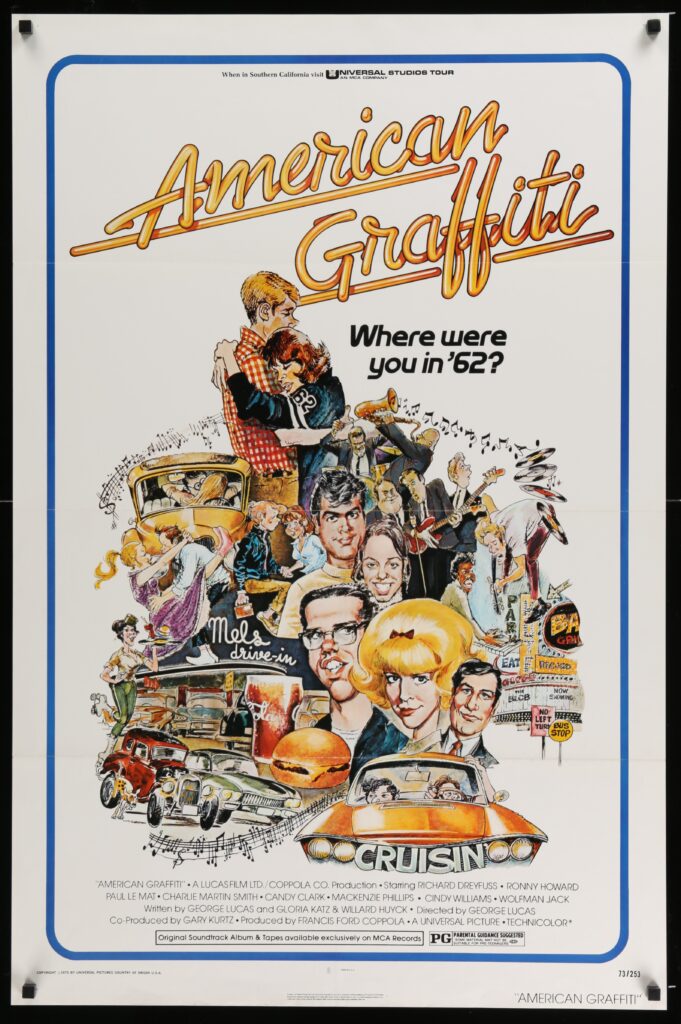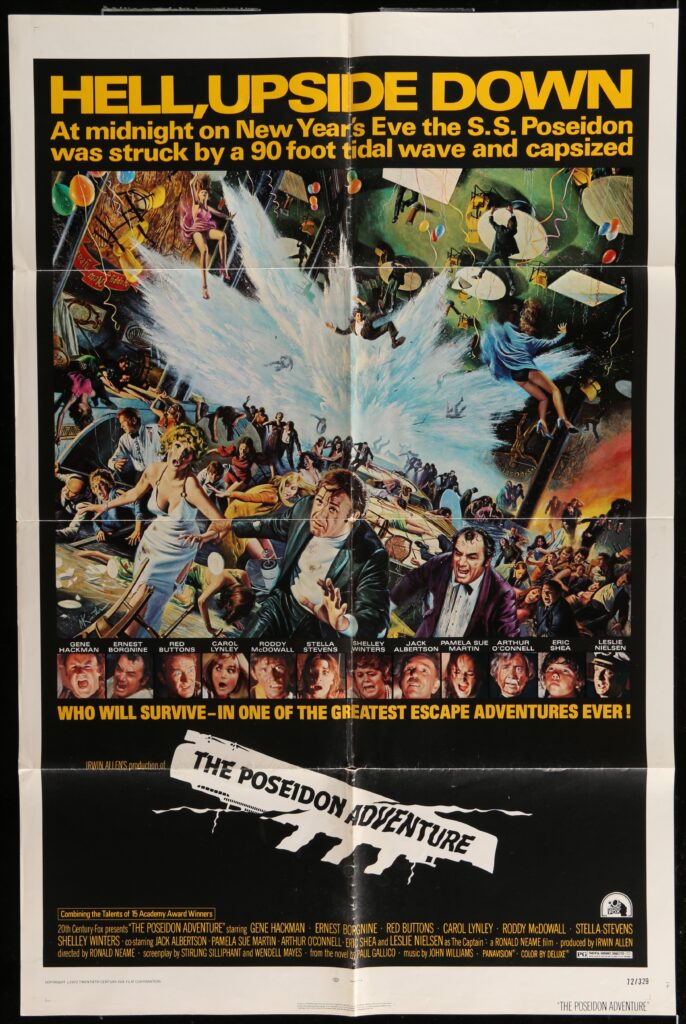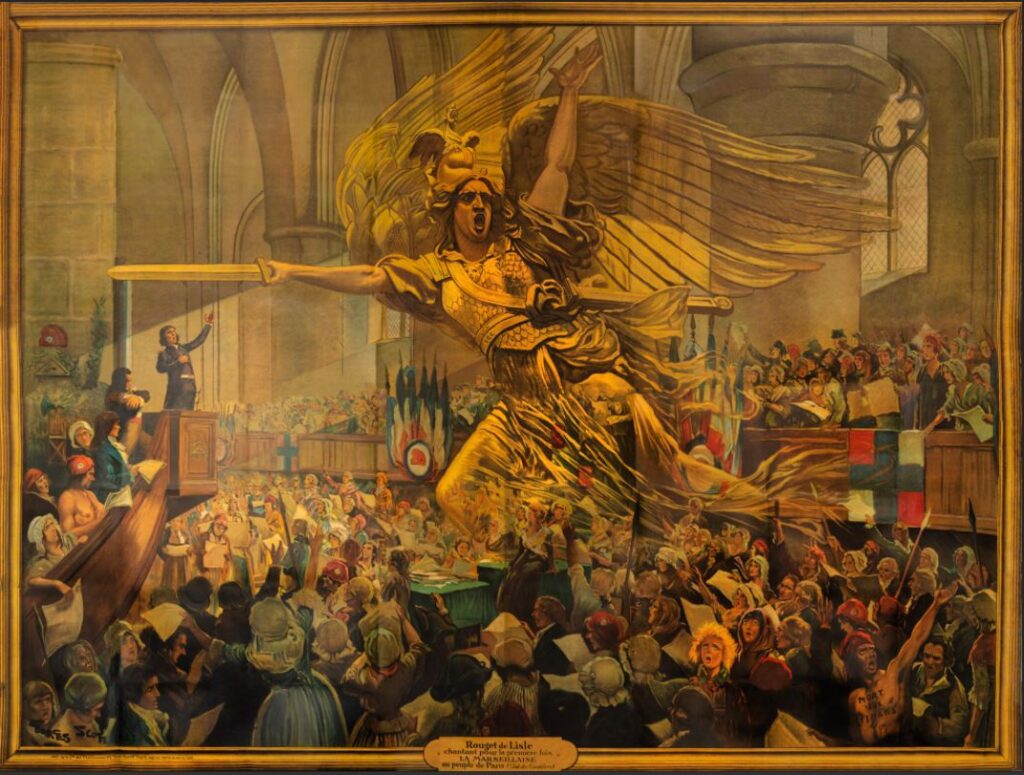
By Philip Vidal
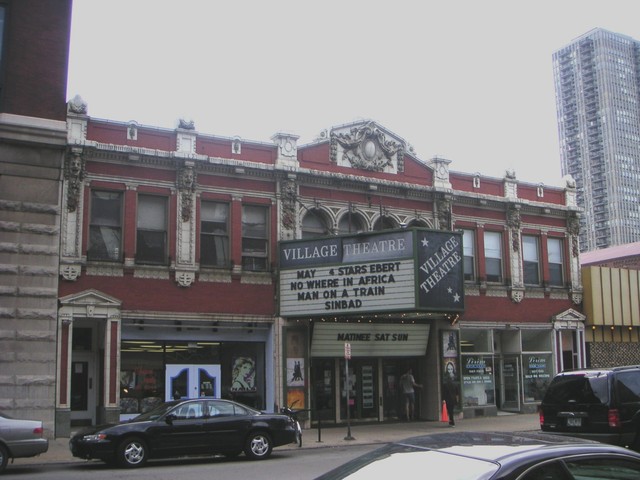 The Village Art Theatre, originally named Germania Theater, on 1548-50 North Clark. Photo courtesy of Ken Roe via Cinema Treasures.
The Village Art Theatre, originally named Germania Theater, on 1548-50 North Clark. Photo courtesy of Ken Roe via Cinema Treasures.
The idea for this article arose from a confluence of circumstances. September 3 was National Cinema Day and on September 4, over Labor Day weekend, I had dinner at the stunning apartment of my friends Paula Litt and Irv Faber who live at 1550 North Clark in Chicago. That location is now a luxurious condominium building, but I remember going there when it was the Village Theatre (aka the Village Art Theatre, originally the Germania Theater, 1916) at 1548-50 North Clark. The façade of the Village Theatre has been preserved, and at the door is a plaque designating the Village Theatre as an official Chicago landmark.
Between the façade of the building and the plaque, I had a Proustian moment and immediately recalled movies I’ve seen over the decades at movie theaters and palaces in Chicago.
My recollections begin before I was born, when I was still in the womb. My mother would recount the story that when she was VERY pregnant with me, her first child, she and her good friend Velma (a fellow graduate of the St. Anne’s Hospital Nursing School at 4950 West Thomas in Chicago’s South Austin neighborhood), who was also VERY pregnant, went to see a movie at one of Chicago’s movie palaces in the Loop. They saw one of the VERY long Biblical epics that were popular in the 1950s. When the movie was over, the realized that their feet and ankles were so swollen that returning home on their own would be impossible. They had to find coins for a payphone to call their husbands to pick them up.
Even at the time my mother was going to movies Downtown, television had already taken its toll on movie theaters across the country. Liveried ushers and usherettes were gone. Movie theaters were either demolished or repurposed. In 1957 two movies acknowledged that TV was a threat to the movie business. In “Will Success Spoil Rock Hunter?,” the title character, Rock Hunter, played by Tony Randall, pokes fun at the new medium of TV and extols the virtues of movie going. In the movie “Silk Stockings,” Fred Astaire and Janis Paige sing the Cole Porter song “Stereophonic Sound,” lamenting that that movies theaters need “glorious Technicolor®, breathtaking Cinemascope®, and stereophonic sound” to lure patrons and compete with TV.
 The Julian Theater, at 918 West Belmont, which was later converted into a church and then demolished. Photo courtesy of narstee via Cinema Treasures.
The Julian Theater, at 918 West Belmont, which was later converted into a church and then demolished. Photo courtesy of narstee via Cinema Treasures.
I grew up in Chicago’s Lakeview East neighborhood, as did my father. He remembered going to the movies at the Julian Theater (1909) at 918 West Belmont in the late 1940s and 1950s. By the time I was growing up in the 1960s, the theater had been converted into a church. It was later demolished. Farther west on Belmont, the Belmont Theater (1926), 1637 West Belmont, was transformed from a movie theater into a bowling alley in the 1960s. It’s now condos.
Some people remember what they wore to an event. Movie going was for me primarily a social event, so I remember (mostly) each movie I saw, where I was seated, and with whom. Like going to a restaurant, you can go the movies alone, but I find it’s a lot more fun going with friends.
“Doctor Zhivago” (1965). Photo courtesy of Dwight M. Cleveland Poster Archive.
Two of my earliest movie-going memories were with my paternal grandmother who took me to our local theater, the Lake Shore Theater (1915) 3175 North Broadway, now the Laugh Factory comedy club, to see one of her favorite movies, “The Sound of Music” (1965). That year, she also took me to see “Doctor Zhivago.” There’s one scene where Dr. Zhivago exams a woman for tuberculosis, so we see her naked back. My grandmother’s hand was quick to cover my eyes.
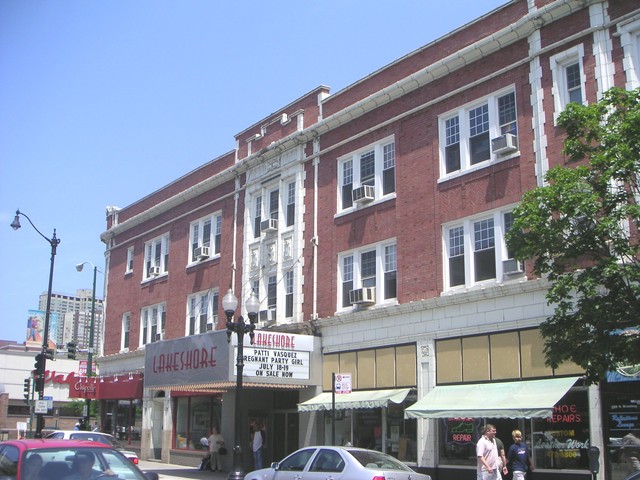 Lake Shore Theater, now the Laugh Factory Comedy Club, at 3175 North Broadway. Photo courtesy of Ken Roe via Cinema Treasures.
Lake Shore Theater, now the Laugh Factory Comedy Club, at 3175 North Broadway. Photo courtesy of Ken Roe via Cinema Treasures.
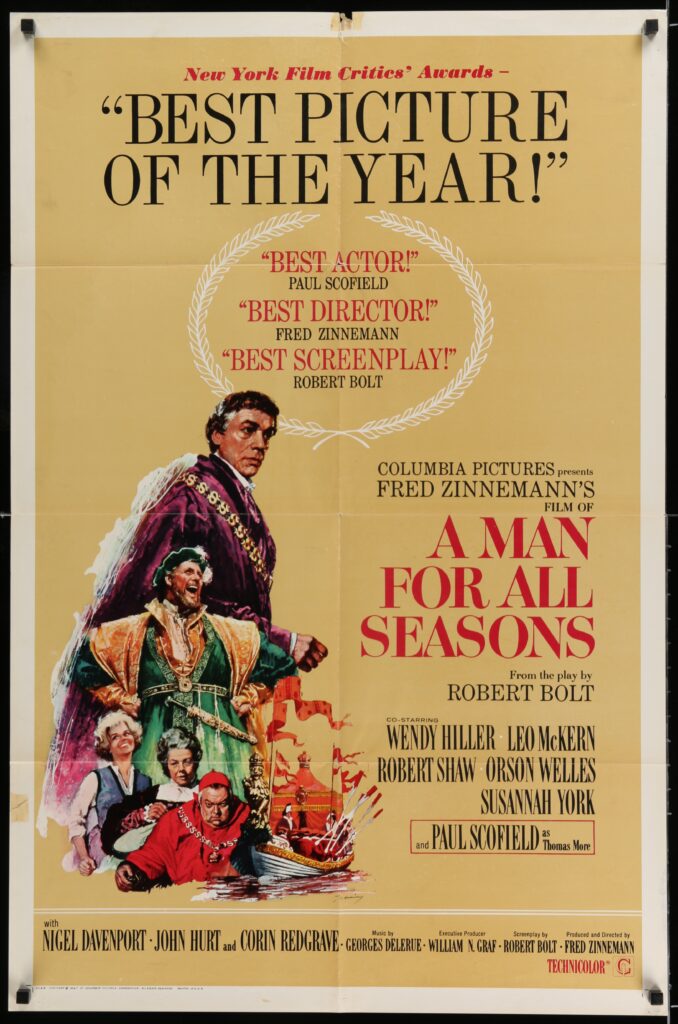 “A Man for All Seasons” (1966). Photo courtesy of Dwight M. Cleveland Poster Archive.
“A Man for All Seasons” (1966). Photo courtesy of Dwight M. Cleveland Poster Archive.
My parents took me to see “A Man for All Seasons” (1966) about Sir Thomas More at the Lake Shore Theater. I remember the theater was packed, and there were many people from the neighborhood and my grammar school, Our Lady of Mount Carmel, who I recognized. Movie theaters were an anchor and part of social fabric of our neighborhood. I recall where I sat, and I left with the indelible understanding to stick to your values and principles, no matter what the cost. Sadly, More paid the ultimate price. The movie made me want to learn more about British history; the scenes of people traversing the Thames in boats manned by rowers got me interested in rowing.
As a field trip, my fourth-grade class went Downtown to see “Doctor Doolittle” (1967) at the Michael Todd Theatre, which was originally the Harris Theater, part of the Harris and Selwyn Theaters (1923) at 180-190 North Dearborn. The Selwyn became the Cinestage. The family-friendly fare at both theaters and others Downtown later turned into XXX adult-themed movies. The façades of the two theaters were preserved and are now incorporated into the Goodman Theatre.
One of the first air-conditioned movie theaters in the world still stands at 3531 West Roosevelt Road, Balaban and Katz’ Central Park Theater. Photo courtesy of Preservation Chicago.
“The Exorcist” (1973). Photo courtesy of Dwight M. Cleveland Poster Archive.
“American Graffiti” (1973). Photo courtesy of Dwight M. Cleveland Poster Archive.
“Jaws” (1975). Photo courtesy of Dwight M. Cleveland Poster Archive.
I also remember sitting in the last row of the packed Lake Shore Theater being frightened to death watching “The Exorcist” (1973), and later being smitten with nostalgia after watching “American Graffiti” (1973) at the Evanston Theater (1937). The summer blockbuster was a new concept in the 1970s, and I recollect seeing “Jaws” at the Lake Shore during the summer of 1975 and being thankful that Lake Michigan didn’t have sharks. Climate controlled movie theaters were a natural draw during the summer months in Chicago, as our Victorian house didn’t have central air-conditioning. The Balaban and Katz’ Central Park Theater (1917), which still stands at 3531 West Roosevelt Road, is regarded as being the first, if not one of the first, air-conditioned movie theaters in the world.
“The Poseidon Adventure” (1972). Photo courtesy of Dwight M. Cleveland Poster Archive.
A poster of Abel Gance’s 1927 silent masterpiece “Napoléon.” Photo courtesy of Dwight M. Cleveland Collection.
Going to the movies was not only a chance to escape the heat, but also a chance to escape the daily grind. But not all my movie memories are positive. I went to The Chicago Theatre (which turns 101 on October 26) at 175 North State, the Loop’s first movie palace, with its iconic sign, to see the “The Poseidon Adventure” (1972) and saw a rat or two scurrying down the aisle. Could they have been supplied to emulate the rats on a ship? On the other hand, after The Chicago Theatre had been completely renovated, I remember seeing a revival of Abel Gance’s silent masterpiece “Napoléon” (1927), which was terrific.
During one of those frigid winters in the late 1970s, I borrowed the family car and took a friend who I’d known since kindergarten to see a movie at the Wilmette Theatre (1913). After the movie, the car wouldn’t start. My friend was not amused. My father had to come pick us up.
Before the internet, you had to wait for reviews in the newspapers or magazines, or watch Gene Siskel and Roger Ebert on PBS/WTTW to see if they gave a movie the thumbs-up or thumbs-down.
One of my sister’s boyfriend’s family had a tradition of seeing a movie on Christmas. It had just opened so there were no reviews yet, but it sounded promising…. a comedy with a stellar cast including Bob Newhart, Madeline Kahn, and Gilda Radner called “First Family.” On December 25, 1980, we headed to the Water Tower Place Theaters (1975) 835 North Michigan Avenue, which were on the mezzanine level then. The film was awful.
 A historic Chicago movie theater located at 3733 North Southport, Music Box Theatre. Photo courtesy of Enjoy Illinois.
A historic Chicago movie theater located at 3733 North Southport, Music Box Theatre. Photo courtesy of Enjoy Illinois.
“Victor/Victoria” (1995). Photo courtesy of Dwight M. Cleveland Poster Archive.
But I can’t cast stones. I have two friends, sisters, who will never go to a movie with me again. I took one of them to “The Comfort of Strangers” (1990) at the Music Box Theatre (1929), 3733 North Southport. I hadn’t read a review, but it also sounded promising. It was set in Venice with a cast including Helen Mirren, Christopher Walken, Natasha Richardson, and Rupert Everett. It was terrible. A few years later, when “Victor/Victoria” (1995) was a huge hit, I read that the Film Center at the School of the Art Institute (I think it was then at 208 South Columbus; now the Gene Siskel Film Center, 164 N State) was showing the original 1933 German version. I took the other sister that evening. The movie was in German with Spanish subtitles. Neither of us spoke German or Spanish. I’ve never lived that one down.
“The Rocky Horror Picture Show” (1975). Photo courtesy of Dwight M. Cleveland Poster Archive.
I regret not going to one of the raucous, interactive screenings of “The Rocky Horror Picture Show.” I would have had a wonderful time, throwing toast in a tuxedo, and sharing the experience with others. I have not gone to a movie during the pandemic, and I miss the group experience a movie in a theater can occasion. Perhaps for that reason I have loved all of the movies I have seen at theaters. Even those that were universally panned, and which friends remind me even now were awful.
Editor’s note: This is the first of a two part series in which our About the Town correspondent shares Chicago movie theater memories.







